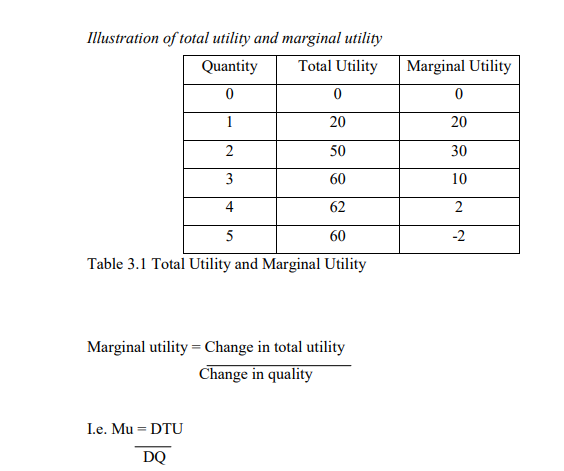It touches on satisfaction other than a customer desire from consuming a particular commodity’s. The satisfaction the consumers derives from consumption of commodity is called utility.
Average utility is the satisfactory per unit consumed on average. Marginal utility is the incremental satisfaction brought about by consuming an extra unit of a commodity. All this is assessed by two schools thought
- Cardinality / Marginal utility Approach
- Ordinals Approach Indifference
1.Cardinalist Marginal Utility Approach
This school of taught believes that utility satisfaction is measurable by use of cardinal numbers. This theory assumes that the consumer‟s satisfaction can be measured in a unit known as utils. An individual demands for a particular commodity because of the
satisfaction/utility received from consuming it. The cardinalist approach assumes that the consumer‟s satisfaction or utility received from consuming a product/service. Up to a point, the more units of a commodity the individual consumes per unit time the greater
the total utility received. Total utility is the total satisfaction received from consuming a commodity. Marginal utility is the extra utility derived from the consumptions of one more unit of a commodity, the consumption of all other goods remaining unchanged. It
explains that individual demand slopes downwards from left to right because of law of diminishing marginal utilities.
The Law of Diminishing Marginal Utility (DMU)
This law states that holding other factors constant as more and more units of a product are consumed one after another the marginal utility falls as the total consumption increases..
Assumptions
1. The consumer is a rational being. As he/she consumes a commodity he goes for those commodities that give maximum satisfaction
2. Price of commodity is constant hence marginal utility of money in constant
3. Quality of the commodity should be consumed in suitable and responsible unit hence consumption should process commodity
4. Trend of the consumer‟s consumption should remain constant.
Exemption of the law of DMU
1) Desire for money, the more money one gets the more satisfaction.
2) Use of liquors-the more and more it is take the more the satisfaction derived
3) Desire for knowledge
4) Personal hobbies/ habits, more and more of this will give high satisfaction.
Application of the law
- It is applied on the bases of customers‟ behavior analysis.
- It is applied in money whereby utility of money for poor people is greater than for the rich.
- It used in the base of progressive taxation whereby the higher the income the higher the tax which led to dissatisfaction
N/B The law applies in many practical situations. For example a person on an exotic holiday to the Maasai Mara will experience increasing in total utility as his holiday proceeds but he is likely to derive greater satisfaction during the earlier days of his holiday than during the late days.
The law of diminishing utility applies provided other factors affecting the consumer’s level utility, apart from the quantity consumed, remain constant. If any of these factors such as taste of fashion change, the law may be temporarily inapplicable until a stable
situation is re-established. For example a person may progress from an occasional buyer of paintings into an obsessive collector or art.


The above illustration shows the relationship between total and marginal utility. A saturation point is reached when the utility is maximum and the marginal utility is at minimum beyond which the total utility starts to decline while marginal utility becomes
negative yielding dissatisfaction.
The Limitation of Utility (Cardinal Utility)
1) It is difficult to make inter-personal comparison of utility since satisfaction is subjective
2) Measurement of utility is difficult since utility is a mental phenomenon even by the help of any instrument hence difficult to determine equilibrium position of a customer.
3) It dose not consider other factors that determine utility such as environment
4) Indivisibility of commodities is not possible to divide some goods into small units in order to equalize marginal utility
5) Ignorance of individual who are some times not aware of the substitute or different goods, e.g. cheap substitute leading items to have low satisfaction from the commodity they consume.
6) Different behaviour of individual due to different customs and fashion